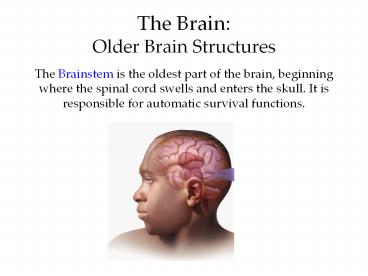The Brain: Older Brain Structures - PowerPoint PPT Presentation
1 / 24
Title:
The Brain: Older Brain Structures
Description:
The Brain: Older Brain Structures The Brainstem is the oldest part of the brain, beginning where the spinal cord swells and enters the skull. It is responsible for ... – PowerPoint PPT presentation
Number of Views:199
Avg rating:3.0/5.0
Title: The Brain: Older Brain Structures
1
The Brain Older Brain Structures
- The Brainstem is the oldest part of the brain,
beginning where the spinal cord swells and enters
the skull. It is responsible for automatic
survival functions.
2
Brainstem
- The Medulla muh-DUL-uh is the base of the
brainstem that controls heartbeat and breathing.
3
Brainstem
- The Thalamus THAL-uh-muss is the brains
sensory switchboard, located on top of the
brainstem. It directs messages to the sensory
areas in the cortex and transmits replies to the
cerebellum and medulla.
4
Brainstem
Reticular Formation is a nerve network in the
brainstem that plays an important role in
controlling arousal.
5
Cerebellum
- The little brain attached to the rear of the
brainstem. It helps coordinate voluntary
movements and balance.
6
The Limbic System
- The Limbic System is a doughnut-shaped system of
neural structures at the border of the brainstem
and cerebrum, associated with emotions such as
fear, aggression and drives for food and sex. It
includes the hippocampus, amygdala, and
hypothalamus.
7
Amygdala
- The Amygdala ah-MIG-dah-la consists of two lima
bean-sized neural clusters linked to the emotions
of fear and anger.
8
Hypothalamus
- The Hypothalamus lies below (hypo) the thalamus.
It directs several maintenance activities like
eating, drinking, body temperature, and control
of emotions. It helps govern the endocrine system
via the pituitary gland.
9
Reward Center
- Rats cross an electrified grid for
self-stimulation when electrodes are placed in
the reward (hypothalamus) center (top picture).
When the limbic system is manipulated, a rat will
navigate fields or climb up a tree (bottom
picture).
Sanjiv Talwar, SUNY Downstate
10
The Cerebral Cortex
- The intricate fabric of interconnected neural
cells that covers the cerebral hemispheres. It is
the bodys ultimate control and information
processing center.
11
Structure of the Cortex
- Each brain hemisphere is divided into four lobes
that are separated by prominent fissures. These
lobes are the frontal lobe (forehead), parietal
lobe (top to rear head), occipital lobe (back
head) and temporal lobe (side of head).
12
Functions of the Cortex
- The Motor Cortex is the area at the rear of the
frontal lobes that control voluntary movements.
The Sensory Cortex (parietal cortex) receives
information from skin surface and sense organs.
13
Visual Function
- The functional MRI scan shows the visual cortex
is active as the subject looks at faces.
Courtesy of V.P. Clark, K. Keill, J. Ma. Maisog,
S. Courtney, L.G. Ungerleider, and J.V. Haxby,
National Institute of Mental Health
14
Auditory Function
- The functional MRI scan shows the auditory cortex
is active in patients who hallucinate.
15
Association Areas
- More intelligent animals have increased
uncommitted or association areas of the cortex.
16
Language http//www.learner.org/resources/series1
42.html
Aphasia is an impairment of language, usually
caused by left hemisphere damage either to
Brocas area (impaired speaking) or to Wernickes
area (impaired understanding).
17
Specialization Integration
- Brain activity when hearing, seeing, and speaking
words
18
The Brains Plasticity http//www.learner.org/res
ources/series142.html
- The brain is sculpted by our genes but also by
our experiences. - Plasticity refers to the brains ability to
modify itself after some types of injury or
illness.
19
Our Divided Brain
- Our brain is divided into two hemispheres.
- The left hemisphere processes reading, writing,
speaking, mathematics, and comprehension skills.
In the 1960s, it was termed as the dominant brain.
20
Splitting the Brain
- A procedure in which the two hemispheres of the
brain are isolated by cutting the connecting
fibers (mainly those of the corpus callosum)
between them.
Corpus Callosum
Courtesy of Terence Williams, University of Iowa
Martin M. Rother
21
Split Brain Patients http//www.learner.org/resou
rces/series142.html
- With the corpus callosum severed, objects (apple)
presented in the right visual field can be named.
Objects (pencil) in the left visual field cannot.
22
Divided Consciousness
23
Try This!
Try drawing one shape with your left hand and one
with your right hand, simultaneously.
BBC
24
Right-Left Differences in the Intact Brain
People with intact brains also show left-right
hemispheric differences in mental abilities. A
number of brain scan studies show normal
individuals engage their right brain when
completing a perceptual task and their left brain
when carrying out a linguistic task.































